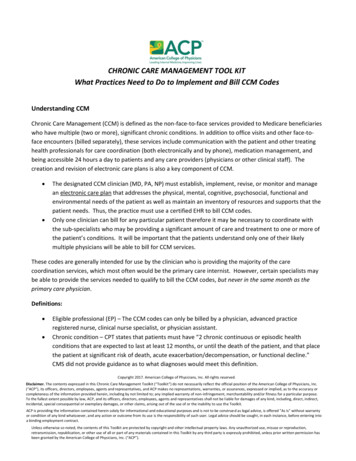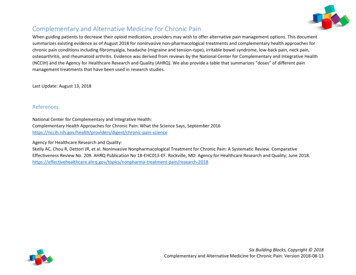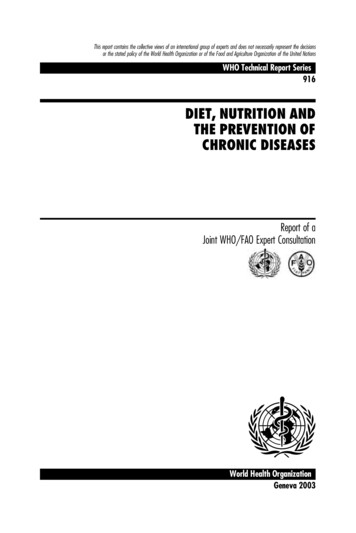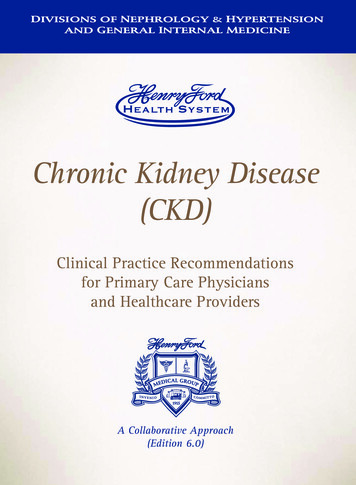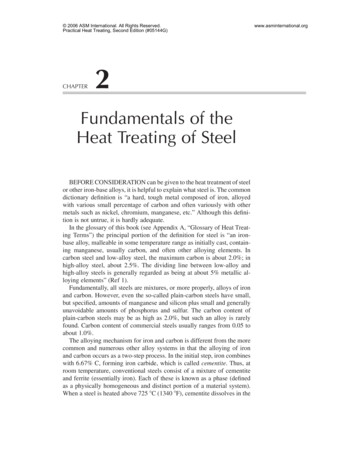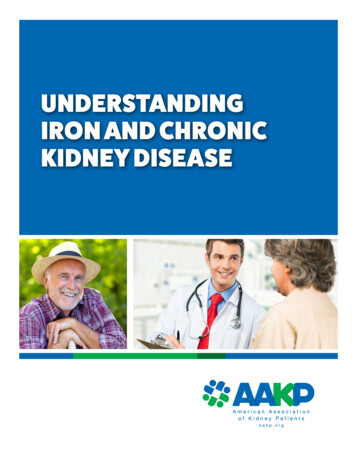
Transcription
UnderstandingUNDERSTANDINGYour AND CHRONICIRONHemodialysisKIDNEYDISEASEAccess Options
UNDERSTANDING IRON ANDCHRONIC KIDNEY DISEASEWHAT IS CHRONIC KIDNEYDISEASE (CKD)?When someone has CKD, itmeans that their kidney functionhas slowed down. These changesusually take place over time.There are a variety of diseasesor conditions that can lead toCKD. Two of these are diabetesand high blood pressure. A lotof people have those diseasesand are at risk for CKD. Otherdiseases present at birth cancause CKD. Among them arePolycystic Kidney Disease,Alport Syndrome, Fabry diseaseamong others.There are five stages of CKD.The stages show how well thekidneys are doing their job. Yourhealthcare provider can do ablood test to see what stage youare in. In Stage 1, there is verylittle kidney damage. By Stage 5,the kidneys will have lost mostof their function. Even thoughcomplications due to CKD, suchas anemia, can start as earlyas CKD stage 3, more serioussymptoms of anemia usuallybecome more noticeable in CKDstage 5. Ask your healthcareprovider to check your bloodto see if you have any signs ofanemia and/or low levels ofiron. If the kidneys continueto lose function, most peoplewill have signs of anemia. Somemay begin to feel the effects ofanemia.WHAT IS ANEMIA?Our blood is made up of mainlyred blood cells, white bloodcells and platelets. When aperson has anemia, it meansthat they have fewer red bloodcells than normal and may nothave enough iron. Why is thatimportant? Red blood cells carryoxygen throughout the body.Organs and tissues need oxygento function and stay healthy. So,fewer red blood cells cause lowoxygen and low oxygen makesus feel weak and tired.WHAT DOES CKD HAVETO DO WITH ANEMIA?The kidneys make a hormonecalled erythropoietin (er-wreathro-po-i-tin). Often it is calledEPO for short. EPO coupled withiron makes red blood cells in thebone marrow. CKD affects theamount of EPO that the kidneysmake. As kidney function getsworse, in the later stages of CKD,the ability for the kidneys toproduce EPO decreases. Patientswhose kidneys are not makingenough EPO will need anerythropoietin stimulating agent(ESA) therapy prescribed bytheir physician. Like naturallyproduced EPO, this ESA therapywill also need iron to make redblood cells.American Association of Kidney Patients: Understanding Iron and Chronic Kidney Disease3
Dialysis patients can lose bloodduring dialysis treatments aswell as due to more frequentblood testing. Not receivingenough ESA therapy and havinga low iron level (not replacingthat lost iron) is the main reasondialysis patients suffer fromanemia.DOES ANEMIA EFFECTHOW I FEEL?If you have anemia, you mayhave a variety of symptoms.4The symptoms may be a lotlike those for other diseases.This can make it hard to tell ifthe way you feel is just due toanemia. Here are some wayspeople say they feel when theyhave anemia. I never have enough energy I feel weak I feel tired It’s hard to concentrate, Ifeel like I have “brain fog” It feels like my heart isbeating too fast Sometimes my heart skipsbeats I get short of breath I am having headaches I am not sleeping very well My appetite does not seem tobe as good as it once was My hands and feet won’t staywarm I may feel dizzy I sometimes feel sad or“down in the dumps” It’s hard to do everydaytasks like make a sandwichor walk up stairsSome people don’t have anysymptoms at first. However, asanemia gets worse, a personmay start having more andmore of these symptoms.American Association of Kidney Patients: Understanding Iron and Chronic Kidney Disease
How can I find out if I haveanemia?If you have any or many of thesesymptoms it may be because: Your body is not naturallyproducing enough EPO; If you are prescribed an ESAtherapy, you may not gettingenough ESA therapy; Your iron levels may be low; You may not be gettingenough dialysis; or You may have an infectionor inflammation.So whether you are on dialysisor not, a thorough check-up isrecommended.If you have any of the symptomsof anemia, tell the healthcareprofessional who is doing yourcheck-up. Your check-up shouldinclude: Questions to find out howyou are feeling right now Current health history Past health history Medication review Physical exam Urine test if indicated Blood testsThe complete blood count orCBC is the main test that tells if aperson has anemia.The CBC also measures: The levels of the differentcells in your blood The number, type, size andshape of the cells in yourbloodTwo of the red blood cell testsare: Hemoglobin (Hgb) is part ofthe blood cell that containsthe iron that takes oxygen totissues and organs. Hematocrit (Hct) tells howmany cells are in a certainamount of blood. This can beused to tell if the number ofred cells in the blood is toolow, just right or too high.Target hemoglobin value:The optimal target Hgb levelfor patients with CKD is notwell defined or “one size fitsall”. In patients with CKD ondialysis or not on dialysis,anemia treatment should beindividualized. A patient’s targetHgb level should be determinedbased on a discussion betweenthe patient and their physicianas to what is best for him/herand how he/she feels and canfunction on a daily basis atvarious Hgb levels.For most CKD patients not ondialysis, who are anemic andare on ESA therapy, Hgb levelsAmerican Association of Kidney Patients: Understanding Iron and Chronic Kidney Disease5
should be maintained between10-11.5 g/dL using the lowestESA dose. The U.S. Food andDrug Administration (FDA)approved label on ESAs statesthat, for patients with CKD whoare not on dialysis, one shouldconsider ESA treatment onlywhen the Hb level is 10 g/dLand reduce or stop the ESA doseif the Hgb level exceeds 10 g/dL.In most dialysis patients whoare anemic and are treatedwith an ESA therapy, Hgb levelsshould be maintained between10 -11.5 g/dL, using the lowestESA dose.Other blood tests are done tocheck how much iron is in thebody. Those tests are: Serum iron – level of ironcirculating in the blood Serum ferritin – amount ofiron stored in the body andinflammation Transferrin saturation orTSAT – amount of iron that isbound to transferrin and canbe used to make red bloodcellsBased on the results of thesetests, your healthcare providermay decide that you need tohave more iron.But before deciding to give iron,they may do additional testsincluding:6 Kidney function if indicated Vitamin B12 level Folic acid level Changes in the blood relatedto other diseasesHOW IS LOW IRONTREATED?If the iron level is low, thefirst step in treating anemiais to raise the iron level. Howand where this is done maydepend on the level of kidneyfunction. The approaches aredifferent for those with CKD notdoing dialysis than those doingdialysis. The type of dialysis andthe place where it is done mayplay a part too.Patients with CKD not ondialysis:Your healthcare provider shouldcheck iron levels and if low, willlikely prescribe oral iron pills(iron pills take by the mouth).If iron pills do not increaseyour iron level, you may needintravenous iron (iron shot inthe vein). If your Hgb is still lowafter iron shots, you may needan ESA therapy to replace yourbody’s natural production ofEPO. ESA shots are like a persontaking insulin shots for diabetes.Your healthcare provider shouldroutinely check your Hgb andAmerican Association of Kidney Patients: Understanding Iron and Chronic Kidney Disease
iron levels to adjust iron and ESAdoses as needed.Patients with CKD on peritonealdialysis or home hemodialysis:Similar to patients with CKD whoare not on dialysis, home dialysispatients should regularly havetheir Hgb and iron levels checked.If a home dialysis patient has lowiron levels, they should start aniron therapy and if Hgb remainslow, they should be started on anESA therapy.Patients with CKD onhemodialysis:Hemodialysis patients tend tolose more iron and have low ironlevels. This is due to blood lossduring hemodialysis because ofwaste during dialysis treatmentas well as due to more frequentblood testing. Most, if not all,of patients on hemodialysisrequire irontreatment, usuallygiven intravenously,in the machine.More recently anew therapy hasbeen approved bythe FDA and hasbecome availablefor patients onhemodialysis. Thenew iron therapy ismixed into a patient’s dialysisfluid (dialysate) and deliveredduring treatment. This dialysateiron therapy does not requireiron to be given intravenously, sono needles are involved.Be sure to ask your healthcareprovider about all available irontherapies and discuss whichtreatment is best for you.CAN I GET IRON FROMFOOD?There are foods rich in iron. Someare not kidney-friendly. If youhave a dietitian, ask them aboutthe foods you can eat. If you don’thave access to a dietitian, askyour healthcare provider to helpyou with this. But you shouldknow that iron just from foodwill not be enough to give you theamount of iron you need.American Association of Kidney Patients: Understanding Iron and Chronic Kidney Disease7
QUESTIONS ABOUT IRON YOU MAY WANTTO ASK YOUR HEALTHCARE TEAM1. What tests are done to check my iron level?2. What do my iron tests show?3. Do the tests show that I need an iron therapy?4. How do you decide what type of iron therapy I need to take?5. Can I use iron pills?6. If I can’t take pills, how will iron be given to me?7. Can I get the iron during my dialysis treatments?8. How will I get iron if I am on hemodialysis?9. How will I get iron if I am on a home dialysis therapy?10. How will I get iron if I am not on dialysis?11. Are there side effects from iron therapies?12. Can I get too much iron?13. How long will I have to take iron therapy?14. How often will you check my iron level?15. Will you go over the test results with me?8American Association of Kidney Patients: Understanding Iron and Chronic Kidney Disease
SUMMARY The body needs iron to make hemoglobin so the red blood cells inthe blood can carry oxygen to tissues and organs. Low iron is a factor in the anemia of chronic kidney disease. Youmay need to take an erythropoetin stimulating agent (ESA) therapyif your body is not producing enough natural erythropoietin (EPO).Your healthcare provider will look at the whole picture and workwith you to develop the best approach to optimal care. There are different types of iron medications and preparations. Iron pills don’t work well for patients on dialysis or with advancedCKD. The decision for what type of iron is used in a dialysis clinic is madeby the dialysis care team. The dose of iron, how it’s given to you and how often it is prescribedis based on what the patient needs. Most hemodialysis patients will get iron therapy during their dialysistreatments. Patients doing home dialysis and those with advanced CKD may getiron via a shot or an IV. Iron from kidney-friendly foods may help but won’t be enough totreat a low iron level and anemia.To learn more about anemia, read the AAKP Understanding Anemia ofChronic Kidney Disease brochure by visiting www.aakp.org or calling(800) 749-2257 to request a copy.American Association of Kidney Patients: Understanding Iron and Chronic Kidney Disease9
WORDS TO KNOW Erythropoietin: A hormone produced by the kidney that helps thedevelopment of red blood cells by the bone marrow. Erythropoietin Stimulating Agent: A therapy commonly used to treatanemia associated with chronic kidney disease when the kidney isnot producing enough erythropoietin naturally. Hemoglobin: The molecule in red blood cells that carries oxygen.NOTESAmerican Association of Kidney Patients: Understanding Iron and Chronic Kidney Disease10
Become a Member ofUnlock all of the AAKP resources today! Just register online to get instant anInstitutionalLife Member 0 45/year 100/year 200/year 1) AnnualSubscriptionaakpRENALIFEMagazine(5) AnnualSubscriptionsaakpRENALIFEMagazine(10) AnnualSubscriptions toaakpRENALIFEMagazineLifetime Subscription toaakpRENALIFE MagazineAAKPE-Newsletters(emailsubscription)AAKP E-Newsletters(email AKP E-Newsletters(email subscription)Life Member Pin &CertificateAAKPEducationalBrochures*AAKP EducationalBrochures*AAKP EducationalBrochures*(1) Set of Printed AAKPEducational Brochures(upon account set-up)AAKP E-Newsletters(email ebinarsAAKPHealthLinewebinars5% Discount on BulkOrders of AAKPEducational Brochures(1) Set of printed AAKPEducational Brochures(upon account set-up)Discount onDiscount on NationalNational Meeting Meeting registrationregistrationwith CEUsDiscount onNational MeetingregistrationAAKPHealthLine webinarsAAKPHealthLine webinarsCenter for PatientEngagement &Advocacy AlertsCenter for PatientEngagement &Advocacy AlertsCenter for PatientEngagement &Advocacy AlertsDiscount on NationalMeeting registrationfor up to (5) employeeswith CEUsDiscount on NationalMeeting registration forup to (2) individuals withCEUs for healthcareprofessionalsAccess to marketresearch andclinical trialsAccess to marketresearch andclinical trialsAccess to marketresearch andclinical trialsCenter for PatientEngagement &Advocacy AlertsCenter for PatientEngagement & AdvocacyAlertsInformation onlocal supportgroupsInformation on localsupport groupsInformation onlocal supportgroupsAccess to marketresearch andclinical trialsAccess to marketresearch andclinical trialsSpeakingopportunities atAAKP programs/eventsSpeakingopportunities atAAKP programs/eventsInformation on localsupport groupsInformation on localsupport groupsSubmit articles forakpRENALIFEmagazineSubmit articles forakpRENALIFEmagazineSpeaking opportunitiesat AAKP programs/eventsSpeaking opportunities atAAKP programs/eventsSubmit articles forakpRENALIFEmagazineSubmit articles forakpRENALIFEmagazine*A small fee is required for print subscription of aakpRENALIFE and educational brochures.To become a member go online to http://www.AAKP.org/Join or call 1-800-749-2257.
This educational program was supported with an educational donation fromwww.rockwellmed.com14440 Bruce B. Downs Blvd.Tampa, FL 33613813-636-8100info@aakp.orgVisit our Web site at twitter.com/KidneyPatientsRev. 4/13
CAN I GET IRON FROM . FOOD? There are foods rich in iron. Some are not kidney-friendly. If you . have a dietitian, ask them about the foods you can eat. If you don’t have access to a dietitian, ask your healthcare provider to help you with this. But you should know that iron just from food

